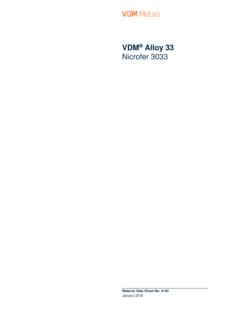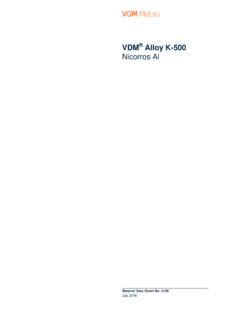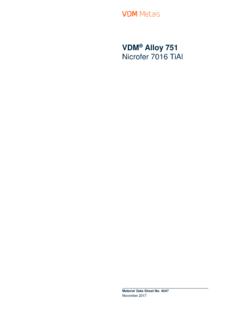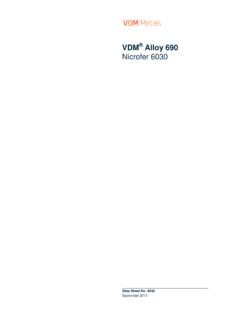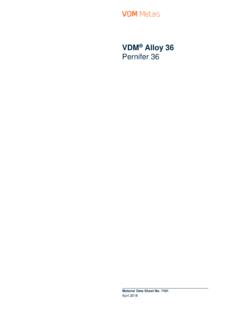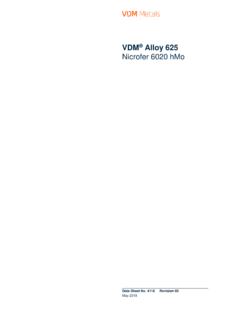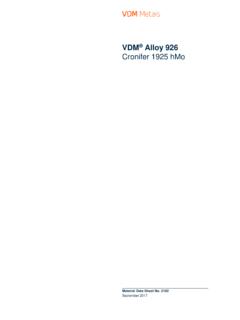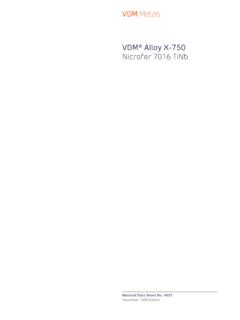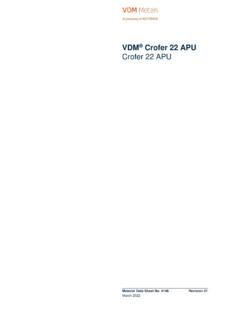Transcription of VDM Alloy 718 CTP Nicrofer 5219 Nb
1 VDM Alloy 718 CTP Nicrofer 5219 Nb Material Data Sheet No. 4127 September 2017 September 2017 VDM Alloy 718 CTP 2 VDM Alloy 718 CTP is an age-hardenable nickel-chromium-iron-molybdenum Alloy . The age hardening is achieved by specific additions of niobium, titanium and aluminum. It can be delivered in the solution-annealed or in different age-hardened conditions. The standard Alloy 718 CTP version has a minimum yield strength of 120 ksi and can be ordered with the material designation 120K. A further variant of Alloy 718 CTP has a minimum yield strength of 150 ksi and can be ordered with the material designation 150K. VDM Alloy 718 CTP is characterized by: Good processing properties in the solution-annealed condition Good mechanical short and long-term properties, and excellent fatigue strength in the age-hardened condition Excellent mechanical properties in low temperatures Excellent resistance to stress corrosion cracking and pitting in chloride-containing media Excellent resistance to stress corrosion cracking and sulfide stress cracking in sour (H2S-containing) oilfield environments Depending on the use conditions, narrower analysis limits apply to certain Alloy elements.
2 This is true in particular for carbon and niobium, but to lesser extent also for aluminum and titanium. The purpose of this limitation is to optimize the structure and mechanical properties with regard to the intended use. VDM Alloy 718 CTP is characterized by limited levels of carbon and niobium. Additional information can be found in the material data sheet of the VDM Alloy 718. Designations Standard Material designation EN - NiCr19Fe19Nb5Mo3 ISO NiCr19Nb5Mo3 UNS N07718 AFNOR NC19 FeNb BS NA 51 Table 1a Designations Standards Product form DIN DIN EN ISO ASTM NACE Others Rod, bar MR 0175 / ISO 15156* API 6 ACRA* Sheet, plate 17750 B 670 Strip 17744 17750 10302 6208 B 670 Wire 17744 17753 * Ballot for inclusion of the 150K variant of Alloy 718 CTP in NACE MR 0175/ISO15156 and API6 ACRA is pending.
3 Table 1b Standards VDM Alloy 718 CTP Nicrofer 5219 Nb September 2017 VDM Alloy 718 CTP 3 Chemical composition Ni Fe C Mn Si Cu Al Ti P S Pb Cr Mo Co B Se Bi Nb + Ta Min. balance Max. Table 2 Chemical composition (%) according to API Standard 6 ACRA, UNS number N07718 Physical properties Density Melting range Relative magnetic permeability at 20 C (68 F) Curie temperature g/cm3 at 20 C (68 F) 1,270-1,340 C (2,318-2,444 F) (Maximum) -195 C (383 F) (solution-annealed) -112 C ( F) (solution-annealed and age-hardened) Temperature Specific heat capacity Thermal conductivity Electrical resistivity Modulus of elasticity Coefficient of thermal expansion C F Jkg K Btulb F Wm K Btu insq. ft h F cm GPa 103 ksi 10-6K 10-6 F 20 68 460 0,110 116 203 100 212 462 0,110 118 199 200 392 476 0,114 121 192 300 572 494 0,118 123 186 400 762 511 0,122 125 179 500 932 521 0,124 127 172 600 1,112 539 0,129 128 165 700 1,292 613 0,146 129 158 800 1,472 617 0,147 130 150 900 1,652 626 0,150 131 142 1,000 1,832 635 0,152 131 134 1,100 2,012 637 0,152 125 1,200 2,192 662 0,158 121 Table 3 Typical physical properties at room and increased temperatures September 2017 VDM Alloy 718 CTP 4 Microstructural properties VDM Alloy 718 CTP has an austenitic microstructure with multiple phases.
4 By means of different heat treatments, graduated mechanical properties of the material can be reached. The excellent mechanical properties of VDM Alloy 718 CTP result from the -formation during the precipitation hardening. Depending on the precipitation hardening tem-perature the size of the -particles vary which leads to different strength properties. More information can be found in the Heat treatment chapter. Mechanical properties The following mechanical properties of VDM Alloy 718 CTP apply to hot or cold-formed material in the age-hardened condition in the specified dimensions. Material with specified properties outside of the listed dimensions ranges (see Availability chapter) must be requested separately. Material designation Temperature Yield strength Rp Tensile strength Rm Elongation A Reduction of area Z C F MPa ksi MPa ksi % % 120K -196 1,138 1,606 28 34 -100 -148 1,049 1,400 27 45 20 68 962 1,256 29 43 100 212 931 1,231 26 38 150 302 913 1,211 24 42 200 392 901 1,196 38 150K 175 347 1040 1237 21 40 205 401 1039 1237 22 39 Table 4 Typical mechanical properties of age-hardened VDM Alloy 718 CTP, material designations 120K and 150K Material designation Product form Dimensions Yield strength Rp Tensile strength Rm Elongation A Reduction of area Z mm in MPa ksi MPa ksi % % 120K Round bar 254 10 827-1,000 120-145 1,034 150 20 35 Round bar 254 10 827-1,000 120-145 1.
5 034 150 20 25 150K Round bar 254 10 1034 150 1241 180 20 35 Round bar 254 10 1034 150 1241 180 20 25 Table 5 Mechanical properties at ambient temperature of age-hardened VDM Alloy 718 CTP, material designations 120K and 150K September 2017 VDM Alloy 718 CTP 5 Charpy V-notch impact toughness Material Designation QTC Cross Section Thickness Orientation Minimum Average Minimum Single Lateral Expansion mm in J ft lbs J ft lbs mm in 120K < 76 < 3 Longitudinal 68 50 61 45 76-254 3-10 Transverse 47 35 41 30 > 254 > 10 Transverse 41 30 37 27 150K < 76 < 3 Longitudinal 68 50 61 45 76-254 3-10 Transverse 47 35 41 30 > 254 > 10 Transverse 41 30 37 27 Table 6 Impact testing shall be performed on a set of three specimens and all tests at or below -60 C (-75 F).
6 Hardness Rockwell HRC Material Designation Hardness HRC min max 120K 32 40* 150K 32 45 Table 7 Hardness according to NACE MR 0175/ISO15156* September 2017 VDM Alloy 718 CTP 6 Corrosion resistance As a result of the high chromium and molybdenum concentrations, VDM Alloy 718 CTP has very good general corro-sion resistance and pitting corrosion resistance in many environments. By virtue of its high nickel content, VDM Alloy 718 CTP also has good resistance against stress corrosion. Applications Due to its excellent corrosion resistance and its good workability, VDM Alloy 718 CTP is versatile in use in the oil and gas industry, in the offshore industry and in marine engineering. The Alloy has proven itself well, especially for oilfield completion equipment in very demanding environments containing H2S, CO2, and high chlorides.
7 The Alloy has also proven itself for highly stressed oilfield components. September 2017 VDM Alloy 718 CTP 7 Fabrication and heat treatment VDM Alloy 718 CTP can be easily processed by both hot and cold forming and can also be machined. Heating It is important that the workpieces are clean and free of any contaminants before and during heat treatment. Sulfur, phosphorus, lead and other low-melting point metals can lead to damage when heat-treating VDM Alloy 718 CTP. This type of contamination is also contained in marking and temperature display paints or pens, and also in lubricating grease, oils, fuels and similar materials. Fuels must have as low a sulfur content as possible. Natural gas should contain less than by weight of sulfur.
8 Heating oil with a maximum sulfur content of by weight is also suitable. Electric furnaces are to be preferred due to precise temperature control and lack of contaminants due to fuel. The furnace tem-perature should be set between neutral and slightly oxidizing and should not change between oxidizing and reducing. The workpieces must not come in direct contact with flames. Hot forming VDM Alloy 718 CTP can be hot-worked at a temperature range of between 1,120 and 900 C (2,048 and 1,652 F). It should be done evenly in order to receive a homogeneous microstructure. The subsequent deformation should be at least 20% and be implemented below 960 C (1,760 F) to achieve an optimal toughness. The cooling down should preferably take place in water.
9 Cold forming The workpieces should be in the solution-annealed condition for cold working. VDM Alloy 718 CPT has a significantly higher work hardening than austenitic stainless steels. This must be taken into account during the design and selection of forming tools and equipment and during the planning of forming processes. Intermediate annealing is necessary for major cold forming work. To achieve a high strength, a combination of cold forming with subsequent age hardening is an option. Heat treatment Various solution-annealing and aging conditions are combined in order to obtain the different required material proper-ties. Since the diffusion rate crucial for the formation of the "-phase is relatively low, long age hardening times are re-quired to achieve the optimal mechanical quality values for VDM Alloy 718 CTP.
10 The material must be placed in a furnace that has been heated up to the maximum annealing temperature before any heat treatment. For strip products, the heat treatment can be performed in a continuous furnace at a speed and temperature that is adapted to the strip thickness. The cleanliness requirements listed under the "Heating" chapter must be observed. Heat treatment for VDM Alloy 718 CTP 120K reference API standard 6 ACRA for use under H2S-containing media: Solution annealing: hours at 1,021-1,052 C (1,870-1,925 F), cooling down in water Age hardening: 6-8 hours at 774-802 C (1,425-1,475 F), cooling down in air or faster Heat treatment for VDM Alloy 718 CTP 150K according to NACE MR0175/ISO15156*: Solution annealing: hours at 1,021-1,052 C (1,870-1,925 F), cooling down in water Age hardening: min.
